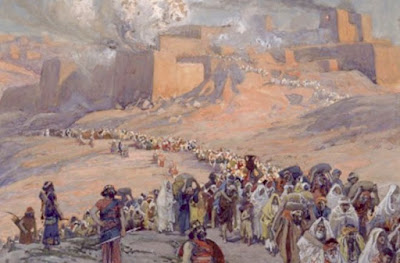 My last post for 2016 is another "road trip": the story of the Magi who traveled to visit the young
My last post for 2016 is another "road trip": the story of the Magi who traveled to visit the young Jesus (Matthew 2:1-12). The lovely story is usually an Epiphany story.
The Magi possibly came several hundred miles, "following yonder star." They weren't "kings," as the old hymn names them, but probably Persian or Babylonian astrologers and dream interpreters of the priestly class. The Bible doesn't actually say how many there were, nor their names. An old joke goes that if the wise men had been wise women, they would've asked for directions, helped deliver the baby, and brought more practical gifts!
The Wise Men were the first Gentiles to pay homage to Jesus. We miss the significance of God's blessing of the Gentiles because we're all Gentiles and we already know that the God of the Hebrews has touched our lives. But if you read Acts and Paul's letters, you can feel a palpable joy at the blessing and generosity of God in showing his love and help for all people.
The story of the Wise Men has given us some very important traditions and theological elements to the church. Let me just highlight four.
The first aspect of the Wise Men: thanks to them, one of the most significant Christmas traditions, coming from Matthew's story, is gift giving. The wise men brought Jesus fine gifts (Matthew 2:11). Thanks to the Wise Men, the church has always had a very strong Christmastime tradition of sharing gifts with those less fortunate. Boxing Day, which is the first weekday after Christmas, is celebrated in some countries: for instance, public workers like mail deliverers received appreciative gifts and workers received food and supplies from employers.
The second aspect is that the nature of their gifts gives us a subtle unifier of what Jesus was about. The Scottish Bible scholar William Barclay notes that gold is the gift of a King, which Jesus certainly is. Frankincense is the gift of a priest. We don't always appreciate the "priestly" role of Jesus, but read Hebrews 4:14-16: "Since, then, we have a great high priest who has passed through the heavens, Jesus, the Son of God, let us hold fast to our confession. For we do not have a high priest who is unable to sympathize with our weaknesses, but we have one who in every respect has been tested as we are, yet without sin. Let us therefore approach the throne of grace with boldness, so that we may receive mercy and find grace to help in time of need." Finally the gift of myrrh implies death, because that substance was valued for its fragrance but was also used in embalming. Without realizing the symbolic significance of their gifts, the Wise Men "preached Christ" as king, priest, and crucified savior.
In my 2009 Advent study book, I remarked that we tend to separate in our imaginations the birth of Jesus from the death and resurrection of Jesus, and I wondered if perhaps we should display both poinsettias and Easter lilies together in our churches. I doubt that will ever be done, but we do well to keep other both Christmas and Easter in our minds. Jesus was born for our salvation, which was eventually achieved by his atoning work on the cross and his resurrection from the death. These aspects of Jesus belong together, because they are all part of God's work of salvation.
The third aspect of the Wise Men is how they highlight God's way of doing things. Matthew and Luke's gospels give a place of honor to the lowly. Luke's gospel in particular continues the strong Old Testament theme that the poor and needy must be provided for, and that God takes the side of the poor. In telling the story of Jesus, Matthew echoes the story of Moses' birth (the threatened ruler, the killing of children, the secret rescue of the child, the location of Egypt) in order to proclaim Jesus as a liberator for his distressed. The modest circumstances of Jesus' birth shows him to be a different kind of king than Caesar or anyone else holding political power. God chose to be born in circumstances mirroring the unfairness, oppression and injustice that we see in the world.
The fourth aspect is related to the third. Pastor Richard Fairchild on the Spirit Network website notes that the Wise Men were open to and recognized King Jesus in spite of the modesty of his circumstances. They came to visit a king, but Jesus lived in a carpenter's simple home. The Wise Men could've assumed they were in the wrong place and kept looking, or given up. Fairchild writes, "So many of us have a hard time accepting what God has given in the form that he gives it. Because we are waiting for a gift from God - we look for great miracles, instant healings, signs and wonders, trumpet calls and 21 gun salutes. We may pray to God for a special blessing - and then turn away at our door a pan-handler who is looking for a meal, or a neighbor who is dropping by unannounced, or a client who shows up just when we are preparing to leave work for the day."
That last point is a good one for us to keep in mind as we prepare for a new calendar year. If you're like me, you hope to grow spiritually and are keenly aware of ways that we fall short. At the same time, we often don't give God credit for doing things differently than our expectations. The great thing is that God is always way ahead of us and seeks to help and guide us along our own journeys. One of the ways in which we grow spiritually is in discernment of God's works in the world. Some of them we miss, because God does things contrary to our expectations. Some of them we see, however. The Wise Men provided wonderful traditions for us, but the example of wisdom about God's purposes is a particularly fine tradition as we look to the Lord for guidance and help for the upcoming year.
(from a 2011 sermon)























